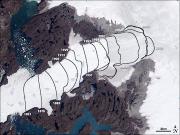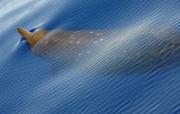Radio Program
Our regular Science and the SeaTM radio program presents marine science topics in an engaging two-minute story format. Our script writers gather ideas for the radio program from the University of Texas Marine Science Institute's researchers and from our very popular college class, Introduction to Oceanography, which we teach to hundreds of non-science majors at The University of Texas at Austin every year. Our radio programs are distributed at to commercial and public radio stations across the country.
New wind-power turbines are popping up off the European coast so quickly these days that it’s hard to keep track of them. By the middle of 2016, more than 3300 offshore turbines had been connected to power grids, supplying enough energy to meet the needs of several million homes.
The main problem with these turbines, of course, is that when the ocean breeze dies down, the electricity is gone with the wind. But several groups are testing ways to store energy to keep the electrons flowing even when the wind isn’t.
We all know that El Niño can have a big impact on the United States. It generally brings cooler, wetter weather to the southwest and the Gulf coast, and drier conditions to much of the rest of the country. And that may have a bigger impact on daily life than just whether you’re likely to need an umbrella. It could change the odds that you’ll get sick.
In the early months of World War I, German submarines were sinking Allied shipping at an alarming rate. There was no way to detect the U-boats when they were submerged, so they could operate with little fear of loss.
Allied powers quickly set out to change that. They eventually developed an early version of sonar -- a technology that uses sound waves to detect underwater targets.
A new national monument is a wonderland of mountains, canyons, and wildlife. Few will ever see it directly, though, because it’s thousands of feet below the surface of the Atlantic Ocean.
President Barack Obama created the Northeast Canyons and Seamounts National Monument in September of 2016. It’s about 150 miles southeast of Cape Cod, and it covers almost 5,000 square miles. It’s the first American marine monument in the Atlantic.
If you happen to be snorkeling in the Indian Ocean some day and you come face to face with what looks like a feather duster, leave it in peace. It’s not trash; it’s a feather star -- a creature that’s related to sea stars.
Like a sea star, it has five arms. But the arms can have many branches -- up to 200 in all. And, the branches are covered with delicate appendages that make them look like feathers.
A glacier in Greenland has been moving at anything but glacial speeds in recent years. In the summer of 2012, it hit a top rate of 150 feet per day -- about 10 miles per year. As a result, it’s dumping more ice into the north Atlantic Ocean, and contributing to the rise in global sea level.
As the ocean tides slosh back and forth, they have several important effects. They help sculpt the coastline, for example, and they cause Earth’s rotation on its axis to slow down. And recent research has shown that the tides create a weak magnetic field. Scientists are using that field to study both the oceans and conditions deep inside our planet.
If whales had their own Olympic games, one of the events might be deep diving. And the gold medal would go to a species known as Cuvier’s whale. A few years ago, one member of the species was tracked to a depth of more than a mile, and it stayed underwater for more than two hours. That’s a record for any marine mammal.
Parts of the northern Atlantic Ocean have experienced a chilldown in recent years. In particular, a large pool of water between Canada and Europe has cooled by about three-quarters of a degree. And some researchers say that could lead to drier conditions across the Atlantic.
Loud music, roaring jet engines, heavy construction, and other piercing sounds are often described as “ear-splitting.” And that’s not far from the truth. They can destroy tiny hairs in the ear that detect sound waves, causing a hearing loss. And so far, there’s no way to repair the damage. But researchers have found some cause for hope in the tentacles of the sea anemone.












